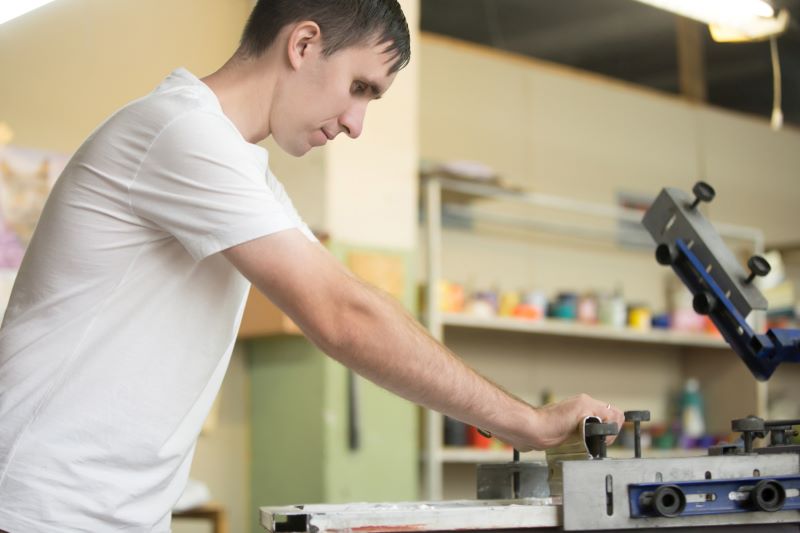
Screen printing is a popular method for printing art, brands or logos, and graphics on articles of clothing and other substrates. Previously, screen printing easily cracked and faded. However, with advances in technology, more ink selections, and extreme heat-curing methods, designs should last as long as the product it’s printed or even after the original product’s life gives out. However, when the printer takes shortcuts, is inexperienced, or uses cheap products, you may see premature fading or other issues.
What Is Custom T-Shirt Screen Printing?
The method dates back to ancient Asia, where they used silk to transfer designs onto fabric. Traditionally, printers used silk stretched over a frame to create a screen where the negative space is blocked. The ink is rolled onto the screen to pass through to the fabric to create the design.
The printer must make a separate screen for each color in the design. They repeat the dying process with each screen until they have the desired finished product on the article. Then, the printer applies certain chemicals or uses unique drying methods to cure and set so the print is permanent.
While the technique is roughly the same, printers nearly never use silk anymore, but the name silkscreen printing persists, so you may hear it called that. The method has evolved into an incredibly clean, precise, and durable form of printing on t-shirts and other articles. However, a few printing mistakes and care problems can lead to fading. Whether you are a consumer, an entrepreneur starting a drop-ship t-shirt company, or just learning the process of screen printing, you should be aware of the factors leading to fading designs.
Poor Print Quality
Several steps in the printing process can lead to fading. For example, if the shop uses low-quality ink or ink unsuitable for the fabric, it can fade, crack or peel off. The same can happen if the printer doesn’t allow the appropriate curing time or heat. This is why you should carefully select a professional screen printing company with expertise, proper equipment, and reasonable quality control so you don’t have to worry about the longevity of the finished product.
Experienced screen printing companies typically perform two tests to ensure they have adequately cured the product, and it will last. After curing and drying, they will perform the wash test to ensure no ink washes away or disappears afterward. The next test would be the stretch test. They will take the item and stretch the fabric where the print is. If the image retains shape and doesn’t crack or peel when the fabric relaxes, it’s appropriately cured and good to go.
Chemical Exposure
Cleaning agents, solvents, and even the wrong laundry detergent or softener can break down a design’s ink, leading to fading. To ensure your customers are happy with their purchases, consider providing laundering instructions. Using a gentle laundry detergent and washing t-shirts inside out to protect the design are typically safe steps to protect and keep it fresh for the most extended amount of time.
Extreme Weather Conditions
Extreme heat or freezing conditions for a prolonged period can affect the quality of your screen-printed items. For this reason, you shouldn’t leave a box of your customized products in the trunk of your car on a summer day or during a mid-winter snow trip.
Prolonged sun exposure can also affect your screen printing. Ultraviolet radiation, typically from sunlight, can break down the ink and cause it to fade. If you wore your shirt outside on sunny days, the process would take a long time. However, leaving your shirt on your car’s seat or dash where the glass magnifies the ultraviolet light for hours can expedite the process.
Abrasion
Frequent friction or abrasions can cause the ink to fade or wear off over time because screen printing layers inks on top of the initial substrate. This can happen from a fully loaded dryer, combined with the heat as it rubs against the drum repeatedly, from frequent contact in sports, or from backpack straps rubbing the edges of the design. You can see fading in your print if you weight lift and a weight rubs in the same spot. There are neverending ways to rub your design away, so starting with a quality printer is crucial unless you don’t care if your design disappears.
Aging
Of course, all materials will slowly degrade over time. Ink will naturally break down, leading to the fading and loss of color. However, you can keep the color intensity for as long as possible with proper care.
You will have specific washing instructions depending on the type of screen printing and ink you’ve chosen. For example, water-based inks are more likely to wash away no matter how you wash them. Ensure you follow the printer’s wash instructions to prevent premature damage or fading.
Screen printing is time-tested, durable, and easy if you or the print shop follow the necessary steps. Take care when screen printing or choose an experienced screen printer to partner with that has a quality guarantee. Chances are, if you order the cheapest printing inks or screen-printed shirts from some massive online retailer without a warranty, you won’t get the print that will outlast the product’s lifespan.
Robert Fisher is the founder and CEO of Thrive Screen Printing and brings extensive experience in the screen printing and fulfillment industry.

